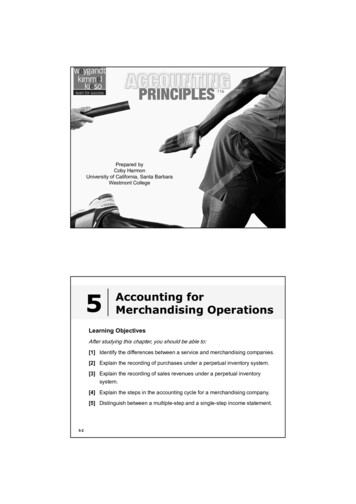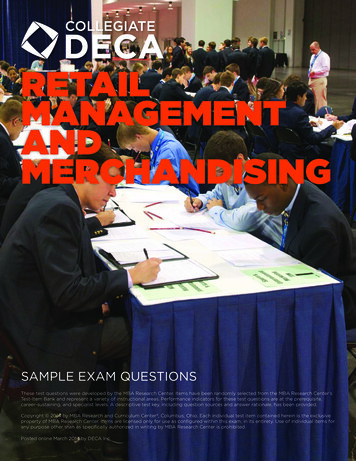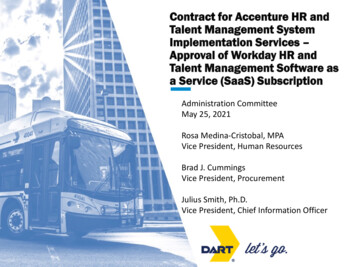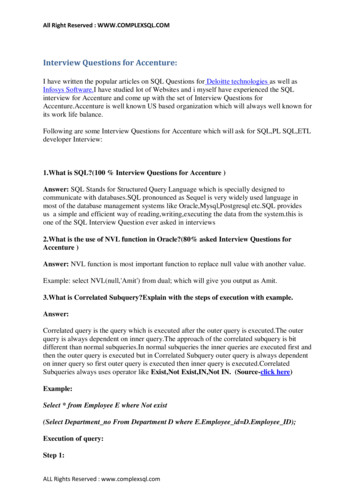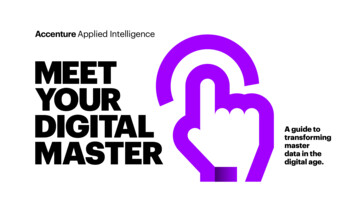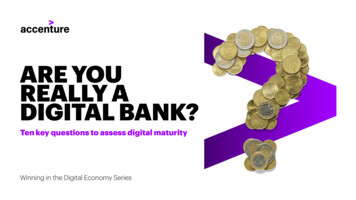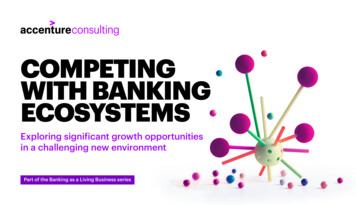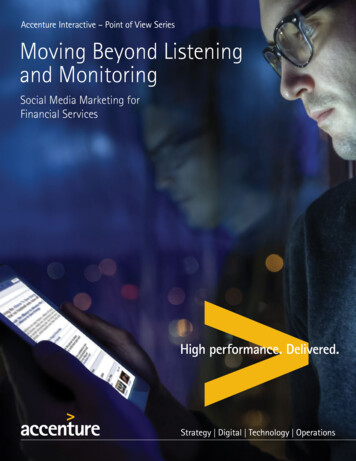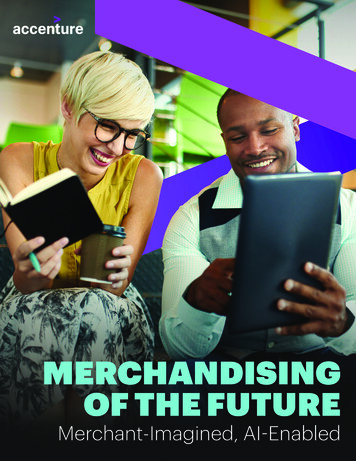
Transcription
MERCHANDISING OF THE FUTUREMerchant-Imagined, AI-Enabled
MERCHANDISINGTODAYRecent retail news focuses on the role of the store in deliveringan omni-channel experience or the dire state of shopping malls.Yet there is much more happening beneath the surface. Retail isundergoing a radical revolution for how it meets consumers’needs—and merchandising is at the center of it all.The merchandising formula that made retailerssuccessful in the past is no longer the one thatwill fuel growth. The role of merchandisinghas undergone mini-makeovers over the past25 years. In the 80s, humans curated, pickedand priced each product for the consumer.Technology advancements in the 90s andearly 2000s applied science at scale in theretail landscape, but via point solutions, suchas assortment planning. These solutionsfailed to give time back to merchants forstrategic thinking, and left them drowning ina sea of spreadsheets. Antiquated processescontinued to hinder innovation over the years.Merchandising today requires a completerethink. Human creativity and inspirationcan be top differentiators that distinguishmarketplace relevancy, leading to increasedrevenue and profitable growth for retailersand dominant brands. Accenture’s leaderin retail operating models, Courtney Spitzstates, “Being successful today requires time,supporting capabilities and collaboratingwith ecosystem partners who can helpretailers compete in an integrated marketplacewhere making a purchase is just a tap, or evena look, away.”“There would be no retail if it weren’t for merchandising,so why isn’t anyone talking about it anymore?”1— Rachel Shechtman, FounderManhattan-based concept store, Story
HISTORY SHOULDN’T REPEAT ITSELFAs merchants adapt to this reality, it is challenging(borderline uncomfortable) to overcome deeplyingrained mindsets. In recent months, Accentureinterviewed top merchants and heard these themes:But still, the daunting bottom line is, “I don’t know what Idon’t know.” So where do merchants start, and what dothey do next? “We need to be bolder and more agile.” “I have no time.” “My team needs to think and act differently,and I need to create roles that will attractand retain top talent.”By allowing merchants to increasingly love their job,they will do a better job. Studies show that companieswith great employee experiences outperformed theS&P 500 by 122 percent. 2
REIMAGININGMERCHANDISINGMerchandising is going to be more critical and creative than ever,focused on activities that make the role more engaging, energizingand fulfilling—and less administratively grueling. The merchant’stime needs to be spent on bringing creative ideas and intelligentexperiences to consumers.NEW MERCHANDISING. NEW MODEL.In an era where consumer expectations,technology capacity and data availabilitymultiply at exponential rates, it is time toadopt a model in which merchants canminimize the number of activities on theirplates and push as much as possible downto an execution layer where specializedteams and/or machines alleviate the burden.This will free up time for merchants to focuson being creative strategists and givingconsumers the exact products and servicesthey want.WHAT IS ARTIFICIAL INTELLIGENCE (AI)?AI includes multiple technologies that extend human capabilities by sensing,comprehending, acting and learning—allowing people to do much more.AI technologies include natural language processing, computer vision, voicerecognition and machine learning. Availability of digital data, computing deliveredthrough the cloud, advanced algorithms and the growth in funding are allowing AIto excel and scale at a pace we have not seen before.In addition to AI, emerging technologies such as immersive reality and quantumcomputing enable companies to become an intelligent enterprise.
FIGURE 1. THE MERCHANDISING MODELOF THE FUTURE.IMAGINE NEW WAYS OF WORKING.HOW WORK GETS DONE AND BY WHOM OR BY WHAT.ENTERPRISE VALUEHighIntelligenceHuman assistedto drive insightsStrategicHuman creativityfor competitivedifferentiationExecutionAutomation todrive precisionLowLowHighTIMEMerchants of the future will concentrate time andcreative efforts differentiating their products andservices, while offloading tasks to machines – seeFigure 1.The new role of the merchant will befocused on delivering the retailer’spurpose to consumers.“Employees place a lot of importancein finding meaning in their work.The closer they feel to the missionand the product or service they areproviding, the higher quality workyou can expect.”3
EXECUTION.INTELLIGENCE.STRATEGIC.Retailers will apply automation tohighly predictable occurrences (e.g.item setup, order management andvendor inquiries) and/or repeatableprocesses that require minimal humanjudgment, thereby reducing errors,saving costs and freeing up time.Retailers will use advancedanalytics to enable precision atscale. Actionable data insightswill direct merchants’ curationand segmentation of merchandiseselections to be hyperlocalized andhyperpersonalized automatically.With execution and intelligencecapabilities in place, merchantscan invest brainpower in inspiringactions that deliver differentiatedvalue propositions.When computers are colleagues thatoversee those left-brain executionand analytic decision-making tasks,the business fundamentals areself-driving. When the businessfundamentals are self-driving,merchants can get back to theircreative roots and dream big. Forexample, according to AccentureRetail Global Managing Director,Shyam Thyagaraj, “Being able toautomatically populate hundreds ofattributes for an item using imagerecognition and deep learningtechniques changes the game ontime-consuming maintenance tasks.”Now, time is freed up to focus onthe outcomes of the process insteadof the process itself.Cognitive, self-learning machineswill not only help with segmentation,they also will ensure that productofferings are tailored to individualconsumers and suited for localneeds, regardless of shoppingchannel. For example, machines cancreate customer choice models thatconfidently predict what consumersprefer to purchase when givenspecific choices, taking demandforecasting to the next level.Higher precision will lead to higherprofitability.Merchants will be equippedto readily sense the needs ofconsumers and respond inmeaningful and innovative ways—giving people what they want,when they want it, from someonethey trust.
AI: MERCHANDISINGMAGICAI can power growth by enhancingthe productivity of people, and it canalso be highly productive by itself.Innovative retailers are not afraid tochallenge which activities can beaccomplished by a machine versusthose that must be done by a human,and are using AI to differentiatethemselves and disrupt the market. One retailer manages its contentusing image recognition to automatethe tagging of product attributes. A leading retailer uses internal andpublicly available external datato identify trends in real-time andpredict their strength and longevityusing machine learning algorithms. FindMine automates the manualprocess of curating window displays,endcaps and online lookbooks,personalizing merchandising forretailers and shoppers. Screenshop uses image recognitionto convert screenshots intoshoppable results, instantaneously. Stitch Fix uses algorithms to predict“frankenstyles” entirely from data,and select relevant items for clients.
MEET THE NEWMERCHANTA merchant transcends what we think of today as a buyer orcategory manager. He or she has become the curator of experiencesand the inventor of offerings for consumers.As AI changes how work getsdone, the job description of themerchant changes, too. Merchantsare the customer experiencedesigners, the trendsetters andthe most important advocatefor the consumer. They serveas the innovation engine for theconsumer offering, experienceand engagement. And mostimportantly, the merchant will beempowered with the right tools andorganizational support to achievethese important outcomes.WHAT’S TRENDING?“Wal-Mart’s Tech Incubator HiresCo-Founder of Rent the Runway”4Leading retailers are hiring ingenuity,while commoditization of buyingpractices is being addressed inother ways.
NEW WAYS OFWORKINGAI offers its greatest value by augmenting the work that people do toimprove the way they interact with their consumers and communities.With machines now part of the workforce, humans will need a differentset of skills, capabilities and culture. The World Economic Forumpredicts that, “by 2020, more than a third of the desired core skill sets ofmost occupations will be comprised of skills that are not yet consideredcrucial to the job today.”2 In addition, merchants need to embrace theircolleagues – whether they are internal, external or robotic.AI and other emerging technologiescan reduce the burden when it comesto transactional, predictable, repetitivetasks—and they have already created newopportunities for humans to work morestrategically and purposefully. Accordingto Accenture research, 84 percent ofworkers surveyed are excited about theimpact of digital on their job and 80percent believe digital will provide moreopportunities in their work experience. 5
IMAGINE.DO.WIN.What’s your winning team going to looklike and how are you going to embraceAI and emerging technologies?The new is now. What are youwaiting for?GET STARTED! Explore AI in action Imagine new ways of working atthe Strategic, Intelligence andExecution layers Block obstacles to innovation Kill the ‘time-suckers’ and foster aculture of inspiration and creativity
FOR MOREINFORMATION,PLEASE CONTACT:North AmericaJill Standishjill.standish@accenture.comEuropeRick Murrayrick.murray@accenture.comABOUT ACCENTUREAccenture is a leading global professional servicescompany, providing a broad range of services andsolutions in strategy, consulting, digital, technologyand operations. Combining unmatched experience andspecialized skills across more than 40 industries and allbusiness functions – underpinned by the world’s largestdelivery network – Accenture works at the intersectionof business and technology to help clients improvetheir performance and create sustainable value fortheir stakeholders. With approximately 425,000 peopleserving clients in more than 120 countries, Accenturedrives innovation to improve the way the world worksand lives. Visit us at www.accenture.com.Asia Pacific LeadYew Hong Kohyew.hong.koh@accenture.comAUTHORSCourtney Spitzcourtney.e.spitz@accenture.comReaves Wimbishm.reaves.wimbish@accenture.comShyam Thyagarajshyam.thyagaraj@accenture.comFOLLOW USON TWITTERSource: “The Future of Retail in the Age of Amazon;” Fast Company,1 November 24, 2017“The Future of Jobs: Employment, Skills and Workforce Strategyfor the Fourth Industrial Revolution;” The World Economic Forum;January 2016; http://www3.weforum.org/docs/WEF FOJ ExecutiveSummary Jobs.pdf2 @AccentureRetailLEARN MORE ATwww.accenture.com/retailSource: “Why the Best Retailers Don’t Have to Worry About3 Turnover;” Fortune, November 1, 2016Source: Bloomberg, April 24, 2017, -the-runway4 5Copyright 2018 Accenture. All rights reserved.Accenture, its logo, and High Performance Delivered aretrademarks of Accenture.“Harnessing Revolution – Creating the Future Workforce”This document is produced by consultants at Accenture as generalguidance. It is not intended to provide specific advice on yourcircumstances. If you require advice or further details on any mattersreferred to, please contact your Accenture representative.
Accenture is a leading global professional services company, providing a broad range of services and solutions in strategy, consulting, digital, technology and operations. Combining unmatched experience and specialized skills across more than 40 industries and all business functions –
